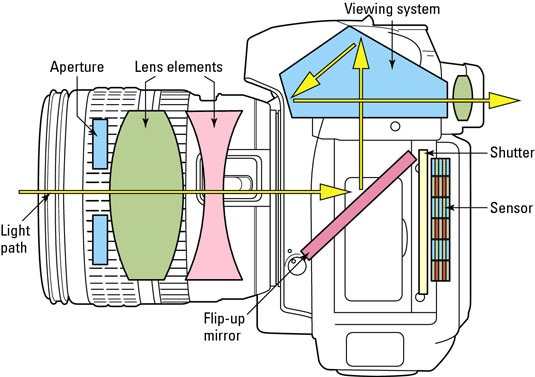A topical subject -- I've just had my sensor professionally cleaned, which led me to research the difference between dust on the sensor, dust in the viewing optics and dust on the lens... which in turn led me to research the specifics of what a sensor is, the different types of sensor you get, and the difference in quality from one to the next.
DUST OMG
If you peer through the camera viewfinder and see dust, then the dust is NOT on your sensor. It will, 99% of the time, be on the reflex mirror, focusing screen or inside the viewfinder itself.
If you consider the diagram above, you can see that any dust on the illustrated path of light will show on the viewfinder. Generally speaking, while this is annoying, it's not the end of the world and won't show up on your images.
If you are seeing little dust spots on your image, it is probably dust on your sensor. Technically speaking it could be on your lens, but it would take a sizeable bit of dust on the lens to show in the final image, due to the way the focusing works. With every lens there's a minimum distance that it will focus at and anything closer gets blurrier and blurrier - well imagine how blurry a tiny dust spec would be right on the front lens element, and you get why it's unlikely to be a dusty lens if you can see it on the final image.
So, dust on the sensor. If you can see it on the viewfinder it won't show on the image - similarly if it's on the sensor you won't see it on the viewfinder. To check for dust on your sensor, mount a lens which can be set to 50mm or longer, close the aperture right up (f/22 or thereabouts), and shoot either a uniform blue sky, or a neutral white/grey surface like a wall. You might be able to see the spots on the LCD screen, or just pull the image off and look at it on your computer. It should be easy enough to spot -- if not, then you clearly have nothing to worry about. :)
Your camera's sensor is the equivalent to the film in film photography. It's the bit that is exposed to the light to generate the image (to continue the analogy further, if the sensor is akin to the film, a RAW image is akin to the negative, and the final JPEG is akin to the print). As such the sensor is incredibly sensitive and really if anything permanent happens to it, your camera is FUBAR.
Cleaning the sensor is a delicate matter. I googled and googled the phrase "sensor cleaning" to hell when my camera had dust, and most more experienced photographers will say it's something you can do yourself as long as you're careful and purchase the right tools. DISCLAIMER: You MUST get specialist tools to clean your sensor and you MUST follow the right procedures to avoid permanent damage. The general procedure involves first using a rocket blower to blast any loose bits of dust off the sensor -- once this is done, you can use a wet-clean technique to remove any bits which are stuck on. It's really important that you use the right tools for this - the right cleaning solution, the right swab -- if you mess up you could cause permanent damage to your sensor.
I could go into all the details but let's face it -- I am a klutz at the best of times. The other night, for example, I dropped a totally NOT hot casserole lid onto the worktop (didn't break thank god), then less than five seconds later, dropped my iPod on the kitchen floor. So when I realised I had dust on my sensor, I sent my camera off to be cleaned by a professional. It wasn't that expensive, and even though I was without my camera for three days, as someone who would have almost definitely ruined the sensor had I cleaned it myself, it was well worth it.
Sensor Size, Crop -vs- Full Frame, and Mega-Pixels
This fantastic post on the Photography Forum explains it much better than I can, PLEASE read it through, but I'll attempt to give my own summary perspective on it a little too.
Basically put, the larger your sensor is, the more light will fall on it. If there is not enough light, the sensor signal must work harder to detect what little light is there, which results in a "noisy" or "grainy" shot. You can manually boost the amount of light that hits your sensor by opening the aperture (a faster lens will help with this), slowing the shutter speed, or upping the ISO, which will make the sensor more sensitive to light -- but will still result in digital noise.
A full-frame camera will contain a sensor which is the equivalent size to a 35mm camera. As a brief aside I'll explain what that means to your field of view. If you're ever looking at lenses and see a phrase like "50mm on a crop sensor, which equates to 80mm in 35mm format", what they're referring to is the effective field of view; a shot taken at 50mm focal length on a crop sensor camera will produce the same result as a shot taken at 80mm on a full-frame camera. So you can extrapolate that to mean that 50mm on a full-frame camera will give a wider field of view.
Anyway, back to the point. The benefit of a full-frame camera is a wider field of view and better low-light performance. The flipside of that is how crazy-expensive they are. Nikon's biggest full-frame model, the D3X, retails at around £5000, whereas even the most expensive crop sensor cameras will usually come in less than £1000.
Now, on to what's known as the MEGAPIXEL MYTH. This is one that I was extremely gratified to read about, as it is kind of annoying hearing people bleat on about how many megapixels their camera has as if that makes it better - something I felt even before I was interested in photography.
A few weeks ago a friend of ours was considering switching away from iPhone to another phone model, and gave the reason that the camera that came with it had 14 megapixels. I still pride myself to this day that I was able to dissuade him from this before I even read up about the megapixel myth, purely by following the logic through in my own mind.
Enough boasting from me. The megapixel myth basically states a fallacy that more MP = better image quality. This is not necessarily true! My DSLR has a modest 10.2MP. Heck, Nikon have a full-frame camera model, the D3S, which has just 12.1MP. The truth is, a smaller sensor has a "sweet spot" when it comes to MP resolution, and if you try and cram more MP into a smaller sensor, you're going to end up compromising the image quality by creating sometimes-unacceptable levels of digital noise. So to Dan I said, it doesn't matter if your phone has a 14MP camera, the sensor is way too small to produce a decent-quality image.
Megapixels do matter to an extent, and especially in two particular areas: cropping and large-scale printing. If you're going to crop a huge amount out of a shot, more MP will allow you to do so and maintain image quality when the shot is scaled up to a bigger size. Similarly, if you're going to take a shot that's meant for, say, a huge wall poster or a billboard, I would imagine the MP count would be important there too.
There's a great article from the New York Times which explains the Megapixel Myth and also some genuine tests that were done to disprove it.
I hope this post has helped you to understand your camera's sensor a little better. Needless to say, the bigger sensor you can afford, the better the image quality will be, and megapixel size is NOT the effective comparison tool you think it is when considering which camera to buy next.
Wednesday, 19 May 2010
Wednesday, 12 May 2010
Off-Topic: Such Tweet Sorrow
For the past five weeks I and many others have been riveted to our Twitter feeds, watching an innovative social "experiment" by the Royal Shakespeare Company and Mudlark Productions. "Such Tweet Sorrow" was a modern-day production of Romeo and Juliet acted out in real time over Twitter, with the six key characters of the play tweeting the storyline to the audience.
When I first heard about the concept I was dubious; the key elements of the play revolve around secrets, lies and misunderstandings -- I couldn't see how they could communicate all this through such a public medium as Twitter, let alone accomplishing all the gravitas and pathos Shakespeare did with his wonderful dialogue.
The six main characters were:
- Juliet Capulet, soon to be 16
- Tybalt Capulet, Juliet's 17-year-old brother (rather than cousin/kinsman)
- Jess Capulet aka Nurse - Juliet's 23-year-old sister
- Romeo Montague, 19
- Mercutio, 19, Romeo's best friend/foster brother
- Laurence Friar, aka Larry, 38, local café owner and soft drug dealer.
The producers were also online, and one supplementary cast member added to the fray a little later was Jago Mosca, a local youth whose addition, in my opinion, was a genius move by Mudlark - as a sneaky observer, he provided much-needed between-the-lines insight in the form of blog posts.
The production got off to an oddly mixed start for me - the first two weeks were spent vociferously establishing the family feud, with all characters being less-than subtle about their hatred for the other camp. The reason for the feud itself was a little shaky - something about a car crash where Mrs. Capulet was killed, Mr. Montague was driving, and Mr. Capulet was so incensed with rage after finding out they had been having an affair that he beat Montague within an inch of his life, causing him to lose an eye.
It was a rocky start, with some followers blogging some thoughtful (if controversial) critique about the characters' tendencies to be a little over the top ("show, don't tell"). However the producers were very open to critique from the followship, and weekly cast meetings took place after which it was plain to see the positive effect the fans were having on the production.
It was clear from the start that the audience immersion was going to be a key point in the success of the production, and no character managed that better than Mercutio. His early links to pictures, audioboos and videos of himself and Romeo out on the town established his character brilliantly, his games of #uploadthatload (where he and Romeo attempted to take sneaky pics of girls' bums and boobs without the girls seeing) and #gamesattheoffice (where he encouraged his followers to make up games to make the time at work go by faster) got the audience involved in a huge way, and he quickly earned himself a massive following, myself included, who dubbed themselves #teammercutio and #mercutiogroupies. After Romeo was grounded by his father, Mercutio's loneliness spilled out onto Twitter and Youtube when he posted a hilarious video of himself miming to Eric Carmen's All By Myself. He was also the first to regularly tweet in character back to the followers, flirting with the girls and getting us all on board. The fan response to him was so strong that it even prompted a huge (and unsuccessful) #savemercutio campaign where the fans begged the producers to let Mercutio bow out in some way that didn't involve his violent and untimely death. Even Mercutio's final hours were hugely interactive, with his final tweet being a shout-out to the #mercutiogroupies (prompting fangirl tears heard the world over). It's my firm belief that without Mercutio, Such Tweet Sorrow could not have had the fanbase it has had.
That's not to say the other characters didn't play their own huge part in making the production as successful as it was. The real turning point for me was the night of the masked ball at the Capulet residence; a stroke of genius prompted the producers to have the Friar create online playlists on Last.fm and Spotify, with Juliet tweeting and Facebooking the start time and encouraging everyone to listen to the playlist from then. It was never going to synchronise exactly due to Spotify adverts and the like, but it did serve to bring all the followers online at one time and multiple picture posts and audioboos throughout the night really set the scene. When the star-crossed lovers eventually clapped eyes on each other the fan reaction was huge (Juliet's "ABORT! ABORT! He's walking over here!" was one of my favourite tweets of the whole play). The inclusion of these real-time events really helped with the audience immersion, even to the point that a simple (if competitive) ping-pong tournament pitting Tybalt against Mercutio had waves of Mercutio fans convinced that day would be his last (it wasn't).
The production hasn't been without its flaws. On Juliet's birthday she received a present of a new mobile phone, and waxing rhapsodic about the precise make, model and features of the phone prompted cries of indignation that product placement was inappropriate and spoiled the experience. I personally wasn't that fussed - Juliet made a maximum of maybe four tweets about it in a short space of time and then never mentioned it again. Juliet herself came under some very severe criticism for losing her virginity to Romeo the night she met him, being completely self-involved, posting a video of places they had "done it" and generally being everything most 16-year-olds are these days. Also the audience was forced to suspend disbelief about certain elements such as tweets going ignored or missed, or emergency services not being called until the very last minute when it was far too late.
The biggest flaw for me, unfortunately, was the finale. It all started at 06:00 UK time on a Wednesday morning, which was incredibly inconvenient for the international followers, some of whom had been committed since day one and were unable to participate due to the time difference. Also despite the actors giving it their all in the final hours, the plot itself was full of holes -- Juliet took propofol, a strong anaesthetic, with the intention of being unconscious and unrousable when her father came to take her to Australia the following morning. Yet she escaped home and went to Friar's house, taking the anaesthetic only to wake up some eleven hours later and discover Romeo's corpse. While the propofol served its purpose in that Romeo mistook her for dead, in terms of the story a beat was missed -- the purpose was supposed to be that Juliet would be able to escape her father's wishes, yet he didn't seem to feature much at all (apart from a very odd and disjointed couple of tweets from Tybalt's account) -- realistically she could have run off to Friar's without the need for the potion at all, or she should have taken the potion at home so her father could discover her. The finale still doesn't make a huge amount of sense to me and feels slightly rushed.
Yet for every incident where one might question the characters' motives, there was at least one moment of pure inspiration: Romeo's Audioboo dedication to his fallen best friend on Mercutio's memorial day will forever stand out as one of the most heart-breaking things I have ever heard. Each character has alternately had times when they were insufferable and sympathetic -- Friar's turn from philosophical father-figure to drunk-every-night blabbermouth was hilarious and tragic all at the same time; similarly Tybalt's rage against the whole world was interspersed with genuine affection for his big sister during her marathon run, and hope for the future when told he could take over the family business, all to great effect. Juliet's final night before taking her sleeping potion was wonderfully produced, with a series of creepy tweets and pictures showing a glass with less and less propofol in it each time.
Overall I would say the production has been a huge success and I will miss it. I'm not alone in hoping that Mudlark carries out another online production like this in the future. After a slightly lacklustre start the actors really came into their own and successfully portrayed believable and sympathetic characters -- to the point where I and many others would occasionally forget we were watching a pre-determined plot play out, and would desperately try and influence the characters' actions in some way to avoid the inevitable tragedy.
Finally this post wouldn't be complete without a shout-out to the fantastic people I have met through this and will continue to follow on Twitter:
@nantoyara
@HenNaTee
@korearian
@EvaPalazzetti
@adventuresofamy
@bigheadzach
@KatWomanNYC
@judeinlondon
@lumilyon
@dca_80
@FrozenGlitter
Folks - without you my enjoyment of this production would have been greatly diminished.
Big thanks to Mudlark and the RSC and congratulations to the players - can't wait to see what the future holds.
When I first heard about the concept I was dubious; the key elements of the play revolve around secrets, lies and misunderstandings -- I couldn't see how they could communicate all this through such a public medium as Twitter, let alone accomplishing all the gravitas and pathos Shakespeare did with his wonderful dialogue.
The six main characters were:
- Juliet Capulet, soon to be 16
- Tybalt Capulet, Juliet's 17-year-old brother (rather than cousin/kinsman)
- Jess Capulet aka Nurse - Juliet's 23-year-old sister
- Romeo Montague, 19
- Mercutio, 19, Romeo's best friend/foster brother
- Laurence Friar, aka Larry, 38, local café owner and soft drug dealer.
The producers were also online, and one supplementary cast member added to the fray a little later was Jago Mosca, a local youth whose addition, in my opinion, was a genius move by Mudlark - as a sneaky observer, he provided much-needed between-the-lines insight in the form of blog posts.
The production got off to an oddly mixed start for me - the first two weeks were spent vociferously establishing the family feud, with all characters being less-than subtle about their hatred for the other camp. The reason for the feud itself was a little shaky - something about a car crash where Mrs. Capulet was killed, Mr. Montague was driving, and Mr. Capulet was so incensed with rage after finding out they had been having an affair that he beat Montague within an inch of his life, causing him to lose an eye.
It was a rocky start, with some followers blogging some thoughtful (if controversial) critique about the characters' tendencies to be a little over the top ("show, don't tell"). However the producers were very open to critique from the followship, and weekly cast meetings took place after which it was plain to see the positive effect the fans were having on the production.
It was clear from the start that the audience immersion was going to be a key point in the success of the production, and no character managed that better than Mercutio. His early links to pictures, audioboos and videos of himself and Romeo out on the town established his character brilliantly, his games of #uploadthatload (where he and Romeo attempted to take sneaky pics of girls' bums and boobs without the girls seeing) and #gamesattheoffice (where he encouraged his followers to make up games to make the time at work go by faster) got the audience involved in a huge way, and he quickly earned himself a massive following, myself included, who dubbed themselves #teammercutio and #mercutiogroupies. After Romeo was grounded by his father, Mercutio's loneliness spilled out onto Twitter and Youtube when he posted a hilarious video of himself miming to Eric Carmen's All By Myself. He was also the first to regularly tweet in character back to the followers, flirting with the girls and getting us all on board. The fan response to him was so strong that it even prompted a huge (and unsuccessful) #savemercutio campaign where the fans begged the producers to let Mercutio bow out in some way that didn't involve his violent and untimely death. Even Mercutio's final hours were hugely interactive, with his final tweet being a shout-out to the #mercutiogroupies (prompting fangirl tears heard the world over). It's my firm belief that without Mercutio, Such Tweet Sorrow could not have had the fanbase it has had.
That's not to say the other characters didn't play their own huge part in making the production as successful as it was. The real turning point for me was the night of the masked ball at the Capulet residence; a stroke of genius prompted the producers to have the Friar create online playlists on Last.fm and Spotify, with Juliet tweeting and Facebooking the start time and encouraging everyone to listen to the playlist from then. It was never going to synchronise exactly due to Spotify adverts and the like, but it did serve to bring all the followers online at one time and multiple picture posts and audioboos throughout the night really set the scene. When the star-crossed lovers eventually clapped eyes on each other the fan reaction was huge (Juliet's "ABORT! ABORT! He's walking over here!" was one of my favourite tweets of the whole play). The inclusion of these real-time events really helped with the audience immersion, even to the point that a simple (if competitive) ping-pong tournament pitting Tybalt against Mercutio had waves of Mercutio fans convinced that day would be his last (it wasn't).
The production hasn't been without its flaws. On Juliet's birthday she received a present of a new mobile phone, and waxing rhapsodic about the precise make, model and features of the phone prompted cries of indignation that product placement was inappropriate and spoiled the experience. I personally wasn't that fussed - Juliet made a maximum of maybe four tweets about it in a short space of time and then never mentioned it again. Juliet herself came under some very severe criticism for losing her virginity to Romeo the night she met him, being completely self-involved, posting a video of places they had "done it" and generally being everything most 16-year-olds are these days. Also the audience was forced to suspend disbelief about certain elements such as tweets going ignored or missed, or emergency services not being called until the very last minute when it was far too late.
The biggest flaw for me, unfortunately, was the finale. It all started at 06:00 UK time on a Wednesday morning, which was incredibly inconvenient for the international followers, some of whom had been committed since day one and were unable to participate due to the time difference. Also despite the actors giving it their all in the final hours, the plot itself was full of holes -- Juliet took propofol, a strong anaesthetic, with the intention of being unconscious and unrousable when her father came to take her to Australia the following morning. Yet she escaped home and went to Friar's house, taking the anaesthetic only to wake up some eleven hours later and discover Romeo's corpse. While the propofol served its purpose in that Romeo mistook her for dead, in terms of the story a beat was missed -- the purpose was supposed to be that Juliet would be able to escape her father's wishes, yet he didn't seem to feature much at all (apart from a very odd and disjointed couple of tweets from Tybalt's account) -- realistically she could have run off to Friar's without the need for the potion at all, or she should have taken the potion at home so her father could discover her. The finale still doesn't make a huge amount of sense to me and feels slightly rushed.
Yet for every incident where one might question the characters' motives, there was at least one moment of pure inspiration: Romeo's Audioboo dedication to his fallen best friend on Mercutio's memorial day will forever stand out as one of the most heart-breaking things I have ever heard. Each character has alternately had times when they were insufferable and sympathetic -- Friar's turn from philosophical father-figure to drunk-every-night blabbermouth was hilarious and tragic all at the same time; similarly Tybalt's rage against the whole world was interspersed with genuine affection for his big sister during her marathon run, and hope for the future when told he could take over the family business, all to great effect. Juliet's final night before taking her sleeping potion was wonderfully produced, with a series of creepy tweets and pictures showing a glass with less and less propofol in it each time.
Overall I would say the production has been a huge success and I will miss it. I'm not alone in hoping that Mudlark carries out another online production like this in the future. After a slightly lacklustre start the actors really came into their own and successfully portrayed believable and sympathetic characters -- to the point where I and many others would occasionally forget we were watching a pre-determined plot play out, and would desperately try and influence the characters' actions in some way to avoid the inevitable tragedy.
Finally this post wouldn't be complete without a shout-out to the fantastic people I have met through this and will continue to follow on Twitter:
@nantoyara
@HenNaTee
@korearian
@EvaPalazzetti
@adventuresofamy
@bigheadzach
@KatWomanNYC
@judeinlondon
@lumilyon
@dca_80
@FrozenGlitter
Folks - without you my enjoyment of this production would have been greatly diminished.
Big thanks to Mudlark and the RSC and congratulations to the players - can't wait to see what the future holds.
Tuesday, 11 May 2010
Bridge Cameras
This post is almost entirely inspired by my bestest friend Imogen, who yesterday emailed me saying her future father-in-law offered to buy her a camera. I love that my geekery is rubbing off on her. The Fuji Finepix range came up as a possible choice, prompting me to research the concept a little for my own education and nosiness.
The term "bridge camera" (aka "megazoom", "superzoom") is kind of an unofficial term used in the photography community to describe cameras which "bridge" the gap between compacts and DSLRs. Key differences between a bridge camera and a DSLR:
- No internal reflex mirror (this one is key! DSLR stands for Digital Single-Lens Reflex)
- No optical viewfinder (due to no reflex mirror) - what you do get instead is an electronic viewfinder
- No interchangeable lenses
- Typically smaller image sensor (not to be confused with megapixel size)
It seems that not all bridge cameras lack the above features though - for example the Samsung NX10 has interchangeable lenses and an APS-C (crop) sized sensor (same as my Sony A230) but is still considered a bridge camera due to no reflex mirror.
Bridge cameras nowadays will appeal to people who want more quality than a compact camera without all the expense and jiggery-pokery of a DSLR. Today's bridge cameras often come with INSANELY long optical zoom lenses - take the Fuji Finepix HS10 which comes with a 24-720mm optical zoom. To put it in perspective, a Nikon 500mm VR lens will set you back at least £5000. That's FIVE THOUSAND POUNDS, folks. As I mentioned in a previous post, optical zoom is much better quality than digital zoom so immediately the HS10 stands out as offering something pretty outstanding for the price.
Now, I can't get into the specific calculations and stuff because, well, it's way beyond my capability, but one of the perceived downsides of a bridge camera is that, even though they do tend to have wide apertures at the wider angles of the lens, the depth-of-field available is not great due to the smaller sensor. This means that unless you specifically position your subject close to the camera and far away from the background, you won't be able to get the blur or bokeh that a DSLR would give you. A shot like the below would not be possible with a bridge camera; the foreground and background flowers would be much more in focus, which means the main subject wouldn't be as well defined:
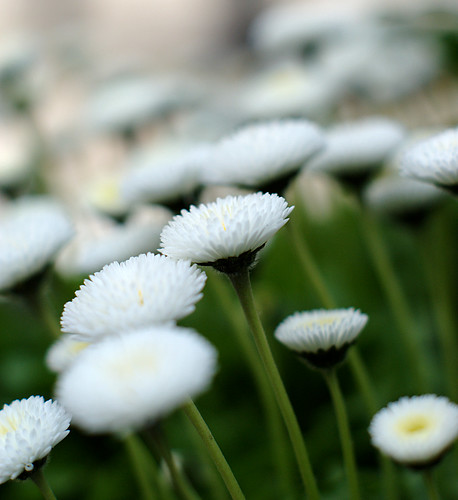
Some of the reviews I have read of a few bridge cameras also have it that the overall image quality is not as good as with a DSLR, as well as there being a little time lag with the scene on the LCD or electronic viewfinder updating with what's actually happening in front of you - this can make a major difference in sports or any shooting where your subject is moving fast.
My personal opinion is that a bridge camera has a very specific niche market -- someone who wants more versatility than your standard compact camera but isn't interested in or ready to get into the real detail and perfectionism of DSLR shooting. If this is you then a bridge camera is a great and affordable choice, but if you do end up really getting into photography and wanting something that delivers a little more, you'll inevitably make the leap into the full DSLR market.
The term "bridge camera" (aka "megazoom", "superzoom") is kind of an unofficial term used in the photography community to describe cameras which "bridge" the gap between compacts and DSLRs. Key differences between a bridge camera and a DSLR:
- No internal reflex mirror (this one is key! DSLR stands for Digital Single-Lens Reflex)
- No optical viewfinder (due to no reflex mirror) - what you do get instead is an electronic viewfinder
- No interchangeable lenses
- Typically smaller image sensor (not to be confused with megapixel size)
It seems that not all bridge cameras lack the above features though - for example the Samsung NX10 has interchangeable lenses and an APS-C (crop) sized sensor (same as my Sony A230) but is still considered a bridge camera due to no reflex mirror.
Bridge cameras nowadays will appeal to people who want more quality than a compact camera without all the expense and jiggery-pokery of a DSLR. Today's bridge cameras often come with INSANELY long optical zoom lenses - take the Fuji Finepix HS10 which comes with a 24-720mm optical zoom. To put it in perspective, a Nikon 500mm VR lens will set you back at least £5000. That's FIVE THOUSAND POUNDS, folks. As I mentioned in a previous post, optical zoom is much better quality than digital zoom so immediately the HS10 stands out as offering something pretty outstanding for the price.
Now, I can't get into the specific calculations and stuff because, well, it's way beyond my capability, but one of the perceived downsides of a bridge camera is that, even though they do tend to have wide apertures at the wider angles of the lens, the depth-of-field available is not great due to the smaller sensor. This means that unless you specifically position your subject close to the camera and far away from the background, you won't be able to get the blur or bokeh that a DSLR would give you. A shot like the below would not be possible with a bridge camera; the foreground and background flowers would be much more in focus, which means the main subject wouldn't be as well defined:

Some of the reviews I have read of a few bridge cameras also have it that the overall image quality is not as good as with a DSLR, as well as there being a little time lag with the scene on the LCD or electronic viewfinder updating with what's actually happening in front of you - this can make a major difference in sports or any shooting where your subject is moving fast.
My personal opinion is that a bridge camera has a very specific niche market -- someone who wants more versatility than your standard compact camera but isn't interested in or ready to get into the real detail and perfectionism of DSLR shooting. If this is you then a bridge camera is a great and affordable choice, but if you do end up really getting into photography and wanting something that delivers a little more, you'll inevitably make the leap into the full DSLR market.
Saturday, 8 May 2010
New Lens - Sigma 70-300mm f/4-5.6 APO DG Macro
In case you didn't know from the number of times I've mentioned it, I got another new lens this week!
The first thing I noticed about the lens is its sheer size and build quality.
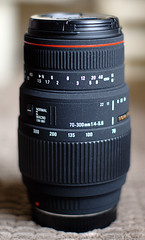
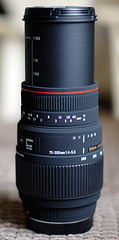


This lens is a bit of a beast compared to my neat-and-petite 50mm. The zoom lens would definitely win in a fight. The build quality is much better as well - it's heavier, with a metal mount instead of a plastic one, and all the parts feel much more robust. The above shots don't really show it, but fully extended with the hood on, it's at least as long as my arm. Considering my camera is one of, if not THE smallest DSLR on the market, it's somewhat disproportionate and makes it really front-heavy.
I mentioned in a previous post what I was intending to use the lens for. I didn't want to wait until France to take it for a test drive, though, so I went for a wander towards the park.
As mentioned previously, this lens has two main functions: zooming in to things further away (duhh), and as a make-shift macro lens.
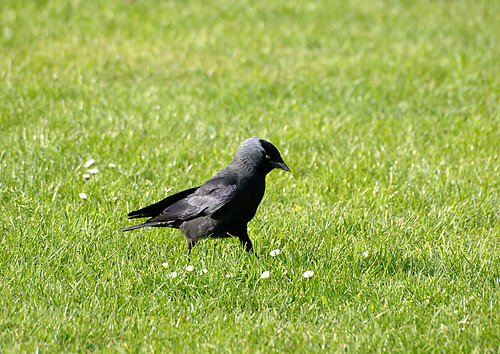
This was purely a test shot and I was pleased at how close I was able to get. I don't think this is a bad shot and it bodes well for my trip to France; being able to get close enough to the players to make out some decent detail.
In terms of the macro function - it's not a true macro lens as it doesn't manage a 1:1 magnification, but if you zoom in further than 200mm and flick the macro switch on the side of the lens, it allows for a minimum focus distance of 95cm, as opposed to the normal 150cm, meaning you can replicate the close-up shooting of a real macro lens by getting closer to your subject and zooming in really far as well. A real macro lens (for example Sigma's 105mm f/2.8 dedicated macro lens) produces this result by allowing for a super-close minimum focus distance of around 30cm (in combination with the long length).
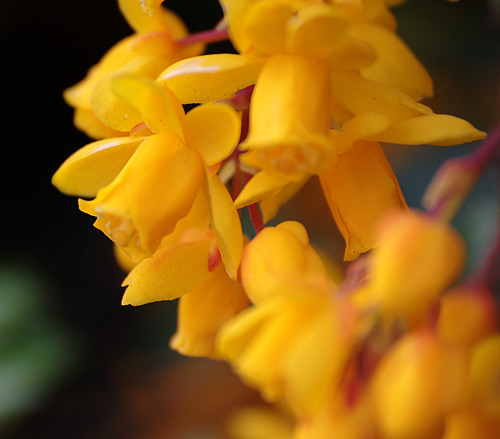
Me being typically me, I was testing the lens at its extremes, and I was pleased with the results. With the 50mm the closest I could get to these flowers was this:
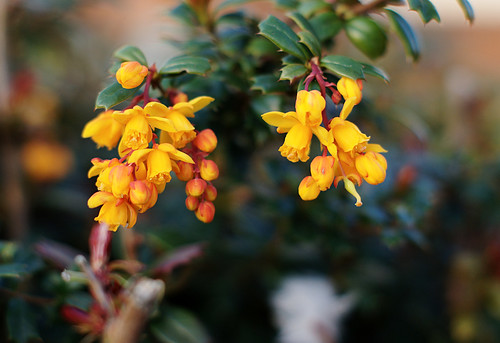
I like the different perspective the lens offers.
The biggest issue I have with it (and this isn't a problem with the lens so much as me needing to modify the way I shoot) is that you really need a tripod to get a steady shot at the longer end. Every minor movement of your hand is magnified massively when you're zoomed in so far.
What did surprise me more than anything else was how sharp this lens is. Even at 300mm I felt like it was much sharper than my other lenses.
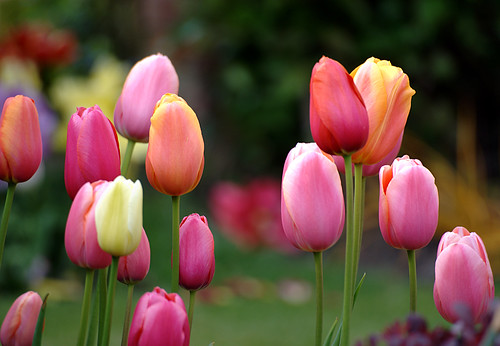
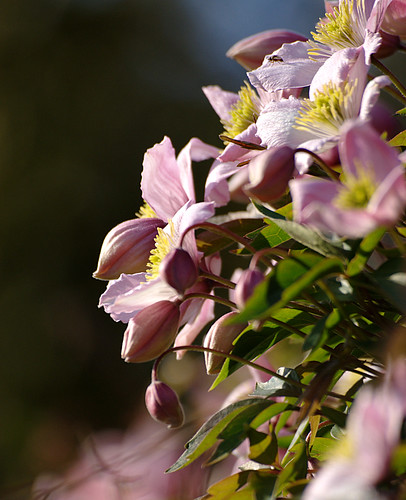
So overall I feel like it was money well spent, and I just need to practise with it so I know its strengths and weaknesses and how best to shoot with it. I also need to take the lens hood out with me and learn when I need to use it; the front glass of the lens is much bigger than my 50mm, and where the 50mm is recessed, this zoom lens is right out there, so there's a lot more potential lens flare. Putting on the hood will mean I need to change settings a little too, so it's all a learning process.
I'm also looking forward to experimenting more with the macro side of things. It offers an interesting perspective on otherwise mundane items:

You can see that the depth of field on this isn't too bad even though the aperture only opens as far as f/5.6 at 300mm.
So I guess it remains to be see how much this new lens gets used overall, but for now I am very happy with it.
The first thing I noticed about the lens is its sheer size and build quality.




This lens is a bit of a beast compared to my neat-and-petite 50mm. The zoom lens would definitely win in a fight. The build quality is much better as well - it's heavier, with a metal mount instead of a plastic one, and all the parts feel much more robust. The above shots don't really show it, but fully extended with the hood on, it's at least as long as my arm. Considering my camera is one of, if not THE smallest DSLR on the market, it's somewhat disproportionate and makes it really front-heavy.
I mentioned in a previous post what I was intending to use the lens for. I didn't want to wait until France to take it for a test drive, though, so I went for a wander towards the park.
As mentioned previously, this lens has two main functions: zooming in to things further away (duhh), and as a make-shift macro lens.

This was purely a test shot and I was pleased at how close I was able to get. I don't think this is a bad shot and it bodes well for my trip to France; being able to get close enough to the players to make out some decent detail.
In terms of the macro function - it's not a true macro lens as it doesn't manage a 1:1 magnification, but if you zoom in further than 200mm and flick the macro switch on the side of the lens, it allows for a minimum focus distance of 95cm, as opposed to the normal 150cm, meaning you can replicate the close-up shooting of a real macro lens by getting closer to your subject and zooming in really far as well. A real macro lens (for example Sigma's 105mm f/2.8 dedicated macro lens) produces this result by allowing for a super-close minimum focus distance of around 30cm (in combination with the long length).

Me being typically me, I was testing the lens at its extremes, and I was pleased with the results. With the 50mm the closest I could get to these flowers was this:

I like the different perspective the lens offers.
The biggest issue I have with it (and this isn't a problem with the lens so much as me needing to modify the way I shoot) is that you really need a tripod to get a steady shot at the longer end. Every minor movement of your hand is magnified massively when you're zoomed in so far.
What did surprise me more than anything else was how sharp this lens is. Even at 300mm I felt like it was much sharper than my other lenses.


So overall I feel like it was money well spent, and I just need to practise with it so I know its strengths and weaknesses and how best to shoot with it. I also need to take the lens hood out with me and learn when I need to use it; the front glass of the lens is much bigger than my 50mm, and where the 50mm is recessed, this zoom lens is right out there, so there's a lot more potential lens flare. Putting on the hood will mean I need to change settings a little too, so it's all a learning process.
I'm also looking forward to experimenting more with the macro side of things. It offers an interesting perspective on otherwise mundane items:

You can see that the depth of field on this isn't too bad even though the aperture only opens as far as f/5.6 at 300mm.
So I guess it remains to be see how much this new lens gets used overall, but for now I am very happy with it.
Thursday, 6 May 2010
Looking Ahead
After the less than positive post I made the other day (not to mention the ticked-off rant a few days later) I have decided, enough with the self-pity, it's time to look ahead. I've started by all-but deciding to give up on the 365 Project. I think I'm over-analysing and thus putting too much pressure on myself.
NEW LENS - WOOT!
I received my Sigma 70-300mm f/4-5.6 APO DG Macro Telephoto lens today. So far all I've done with it (as I am at work) is show it off; I haven't had a chance to play with it yet. The short-term purpose of me buying this lens is that I am going to France in a couple of weeks with Imogen, to watch the French Open tennis. Tennis has been a passion of mine (spectator rather than participant -- good god, no) since I was 14, and we went last year and had an absolutely amazing time. Obviously this time last year I wasn't interested in photography at all and just took my crappy 5MP point-and-shoot, which even then was about four years out-of-date. Imogen had a much newer P&S compact and I remember feeling amazed and very jealous at how close her camera could zoom in.
Obviously, subsequently I've learned that the massive zoom on her camera was digital rather than optical. What this means is that it zoomed in to a certain extent with the lens, then for the rest of the distance the camera would crop and enlarge the scene on the LCD screen, interpolating the pixels digitally, which thus gave a much lower quality shot than an optical zoom, which takes you all the way with the glass.
The new lens I have should get me virtually all the way in to the players even from the stands, and still give me relatively high quality shots. I am fully aware that at less than £200 the lens is considered a budget lens, and thus the quality will never be as great as anything you'd see in a magazine; reviews generally state that at either extreme end (70mm and 300mm) the quality drops off a bit, and with the maximum aperture at 300mm being f/5.6 it's not a dazzlingly fast lens either. HOWEVER, given that for this holiday I'll be shooting in broad daylight, I'm hoping the aperture shouldn't be too much of an issue, and as for quality... well it will be in keeping with the quality of the budget lenses I already have, I should think.
Where I am going to put this lens when carrying it around, I don't know. It's enormous. I mean seriously, with fully-extended zoom and focus rings, it's more like a cannon. I shall feel very conspicuous when shooting - even more so if I need to attach the lens hood!
My other purpose for this lens is that Ste plays rugby and when the season starts again I'd like to actually attend one or more of his matches (which I am yet to do - I'm such a chicken) and shoot the players.
The lens also has a macro function - while at 1:2 magnification this isn't "true" macro (which gives a 1:1 magnification of the subject), I think for experimenting it should suffice and if I really find myself using it more for macro than anything else, I will eventually spring for a dedicated macro lens. Easier said than done considering the lens I have my eye on comes in at around £400.
I don't think I'll use the new lens anywhere near as much as I have used the nifty-fifty but it will get a workout and if it starts collecting dust I can always sell it.
OH NOES
In other news, yesterday I was perusing some random sky shots I took the other day (while waiting 20 minutes in the freezing cold to be picked up) and I realised I have dust on my CCD sensor.

THIS IS A BIG DEAL.
Ok it's not the biggest deal in the world. The spots are only visible against uniform coloured shots like skies or white backgrounds, there are only about six spots visible at the narrowest aperture, and if I open up the aperture you can only see about two. They are easily edited out in post-processing using the clone tool. However being the deranged lunatic I am I simply cannot rest easy knowing they are there, so I'm taking the camera to be thoroughly cleaned early next week. I've discovered that Park Cameras, one of the biggest independent specialists in the UK, is actually based in Burgess Hill, which is about a 40 minute drive from me, ten minutes from Imogen, and even better, about 2.5 minutes from where Ste works. In retrospect it's a good thing I didn't realise they were so close-by -- I would almost definitely have been in there every time I've visited Imogen and thus bankrupted myself for all eternity.
I decided to get Ste to take the camera in on Monday so I can play with my new lens this weekend. I hope the weather isn't too bad.
So that's what I've got coming up over the next couple of weeks. I'm hoping that relaxing by taking a step back from the 365 Project will help me rediscover the fire. Wish me luck!
NEW LENS - WOOT!
I received my Sigma 70-300mm f/4-5.6 APO DG Macro Telephoto lens today. So far all I've done with it (as I am at work) is show it off; I haven't had a chance to play with it yet. The short-term purpose of me buying this lens is that I am going to France in a couple of weeks with Imogen, to watch the French Open tennis. Tennis has been a passion of mine (spectator rather than participant -- good god, no) since I was 14, and we went last year and had an absolutely amazing time. Obviously this time last year I wasn't interested in photography at all and just took my crappy 5MP point-and-shoot, which even then was about four years out-of-date. Imogen had a much newer P&S compact and I remember feeling amazed and very jealous at how close her camera could zoom in.
Obviously, subsequently I've learned that the massive zoom on her camera was digital rather than optical. What this means is that it zoomed in to a certain extent with the lens, then for the rest of the distance the camera would crop and enlarge the scene on the LCD screen, interpolating the pixels digitally, which thus gave a much lower quality shot than an optical zoom, which takes you all the way with the glass.
The new lens I have should get me virtually all the way in to the players even from the stands, and still give me relatively high quality shots. I am fully aware that at less than £200 the lens is considered a budget lens, and thus the quality will never be as great as anything you'd see in a magazine; reviews generally state that at either extreme end (70mm and 300mm) the quality drops off a bit, and with the maximum aperture at 300mm being f/5.6 it's not a dazzlingly fast lens either. HOWEVER, given that for this holiday I'll be shooting in broad daylight, I'm hoping the aperture shouldn't be too much of an issue, and as for quality... well it will be in keeping with the quality of the budget lenses I already have, I should think.
Where I am going to put this lens when carrying it around, I don't know. It's enormous. I mean seriously, with fully-extended zoom and focus rings, it's more like a cannon. I shall feel very conspicuous when shooting - even more so if I need to attach the lens hood!
My other purpose for this lens is that Ste plays rugby and when the season starts again I'd like to actually attend one or more of his matches (which I am yet to do - I'm such a chicken) and shoot the players.
The lens also has a macro function - while at 1:2 magnification this isn't "true" macro (which gives a 1:1 magnification of the subject), I think for experimenting it should suffice and if I really find myself using it more for macro than anything else, I will eventually spring for a dedicated macro lens. Easier said than done considering the lens I have my eye on comes in at around £400.
I don't think I'll use the new lens anywhere near as much as I have used the nifty-fifty but it will get a workout and if it starts collecting dust I can always sell it.
OH NOES
In other news, yesterday I was perusing some random sky shots I took the other day (while waiting 20 minutes in the freezing cold to be picked up) and I realised I have dust on my CCD sensor.

THIS IS A BIG DEAL.
Ok it's not the biggest deal in the world. The spots are only visible against uniform coloured shots like skies or white backgrounds, there are only about six spots visible at the narrowest aperture, and if I open up the aperture you can only see about two. They are easily edited out in post-processing using the clone tool. However being the deranged lunatic I am I simply cannot rest easy knowing they are there, so I'm taking the camera to be thoroughly cleaned early next week. I've discovered that Park Cameras, one of the biggest independent specialists in the UK, is actually based in Burgess Hill, which is about a 40 minute drive from me, ten minutes from Imogen, and even better, about 2.5 minutes from where Ste works. In retrospect it's a good thing I didn't realise they were so close-by -- I would almost definitely have been in there every time I've visited Imogen and thus bankrupted myself for all eternity.
I decided to get Ste to take the camera in on Monday so I can play with my new lens this weekend. I hope the weather isn't too bad.
So that's what I've got coming up over the next couple of weeks. I'm hoping that relaxing by taking a step back from the 365 Project will help me rediscover the fire. Wish me luck!
Tuesday, 4 May 2010
Peeves
I had an odd conversation with someone recently which has stuck with me ever since. I feel awkward even typing this post out, but I wanted to get some of what was said to me off my chest, by listing some of the photography peeves of mine that came up in the conversation (in the way of "I'm surprised you don't do this..." needles), as well as some other little things that I always try and avoid.
On-Camera Flash
Since I received my nifty fifty I haven't switched my on-camera flash on once. I hate it, and the general consensus in the online photography community is that on-board flash is only to be used for ultimate convenience in certain situations. That's not to say that a flash shouldn't be used at all -- certainly, if you have a flashgun mounted on your camera's hotshoe, that is already a step up from the on-board. The great thing about flashguns is that you can set their power manually, bounce the light off ceilings and walls, soften it with diffusers, and even mount them remotely on light stands with softboxes, reflectors, umbrellas etc. Then you're really getting into elaborate and excellent lighting setups which I would never turn my nose up at.
My point is this: on-board flash, even if you can scale it back a little in the settings, will more often than not end up with your pictures being flat, the subjects (especially people) being washed out, the shadows too harsh and unflattering.
Eek! (sorry Mike)
In this situation, I did not have my nifty fifty, and with my kit lens the widest aperture I could manage with this was f/3.5 at the lenses widest angle (18mm focal length). The further you zoom in, the narrower the minimum aperture is. Even with higher ISO (this shot was taken at ISO-800) the camera would have chosen a really slow shutter speed to let in the right amount of light; heck, even with the flash on, it still chose 1/60th, which is considerably slower than I would prefer.
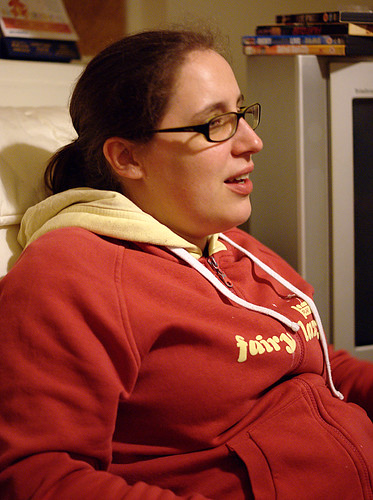
This shot was taken with the 50mm, at f/1.8 and ISO-800. The shutter speed is still pretty slow at 1/30th but despite that you can see that the shot is reasonably well exposed and the shadows are soft and natural. Imogen's skin doesn't look pale, pasty, oddly-coloured and generally scary like Mike's did (sorry again, Mike). In my opinion it's a much nicer shot to look at.
So yeah - where possible, say no to on-board flash!
Prime vs Zoom Lenses
A little information first. A prime lens is one that has a fixed focal length (e.g. my 50mm); in other words, you can't zoom in and out.
There's a very simple reason that anyone would own a lens like this, and that reason is they want a "fast" lens which is affordable. By fast, what I mean is that the lens has a much wider maximum aperture than the affordable zoom lenses. For example, my 18-55mm zoom lens, which came with the camera, has a maximum aperture of f/3.5 at 18mm or f/5.6 at 55mm. The 50mm prime is of a comparable price and has a maximum aperture of f/1.8 -- significantly faster.
It is possible to get fast zoom lenses with maximum apertures of around f/2.8. If you're rich. A Sigma 18-50mm f/2.8 lens retails at around £400. I recently bought a 70-300mm f/4-5.6 zoom lens for £148; a Sigma 70-200 f/2.8 lens will set me back around £800.
Ok, so that's the lead-up knowledge for ya. This inherently isn't my peeve. My peeve is when people pick up my camera and rotate the focus ring when it's locked in to Auto Focus, thinking it's the zoom ring, then either don't listen to me when I tell them not to and continue to do it, or look at me as if I'm crazy to own a non-zooming lens. Ste rightly told me to stop letting people hold my camera without telling them this first but sometimes they just see a shiny toy and want to play. If the focus ring is locked in to AF and they move it, they can potentially damage the mechanism.
Know Your Settings!
I don't deny that people can take great shots in any number of scenarios, but I stand by the belief that they will mostly luck into them unless they at least KNOW what each of their camera's settings is for. Even if you shoot in Shutter Speed Priority or Aperture Priority, you should know why and how the shutter speed or aperture you choose will affect the rest of the camera's settings, so you will understand the resulting shot and know how to correct it in-camera if anything is wrong or not to your liking.
And remember that shallow depth-of-field is a side effect of opening the aperture, even if most photographers use this feature intentionally. The main purpose of a wider aperture is to let in more light.
A Big Lens Does Not a DSLR Make
Just because your camera has a big lens on the front doesn't make it a DSLR. Conversely, just because my camera is small doesn't NOT make it a DSLR. The presence of a reflex mirror behind the lens is what defines a camera as SLR or not. SLR doesn't necessarily mean better, it's just a definition of the type of camera.
Don't Use Your In-Camera B&W Setting
Why any serious photographer, amateur or not, would do this is utterly beyond me, but turning a shot from colour into black-and-white should always be done in post-processing. Otherwise you have no control over the shadows and highlights, and your shot will come out looking flat and dreary and your skin-tones will be dull.
Editing Shots is Part of the Process!
If you think professionals back in the darkroom days didn't perform any sort of processing techniques to get the results they wanted, you're out of your mind. Each person is entitled to produce whatever photographic results they want and the level of post-processing they apply is up to them -- it's a creative artform and it's all very subjective.
However it does irk me when people look down on post-processing as being impure. Get over yourselves! I've looked over some of the shots of these purists and let me tell you, they needed a lesson in post-processing, especially when it comes to the Unsharp Mask.
Recently I saw a really pretentious discussion where the purists accused the Photoshoppers of essentially cheating in a contest, because their expensive software package gave them an unfair advantage. However, open source programs such as The GIMP, GIMPshop or dozens of other free and online editing software packages are so easily available as to totally nullify that argument.
Beauty Really is in the Eye of the Beholder
Just because you don't like my subject matter doesn't mean it isn't relevant to me or someone else.
sigh... I think I'm done.
For now.
On-Camera Flash
Since I received my nifty fifty I haven't switched my on-camera flash on once. I hate it, and the general consensus in the online photography community is that on-board flash is only to be used for ultimate convenience in certain situations. That's not to say that a flash shouldn't be used at all -- certainly, if you have a flashgun mounted on your camera's hotshoe, that is already a step up from the on-board. The great thing about flashguns is that you can set their power manually, bounce the light off ceilings and walls, soften it with diffusers, and even mount them remotely on light stands with softboxes, reflectors, umbrellas etc. Then you're really getting into elaborate and excellent lighting setups which I would never turn my nose up at.
My point is this: on-board flash, even if you can scale it back a little in the settings, will more often than not end up with your pictures being flat, the subjects (especially people) being washed out, the shadows too harsh and unflattering.
Eek! (sorry Mike)
In this situation, I did not have my nifty fifty, and with my kit lens the widest aperture I could manage with this was f/3.5 at the lenses widest angle (18mm focal length). The further you zoom in, the narrower the minimum aperture is. Even with higher ISO (this shot was taken at ISO-800) the camera would have chosen a really slow shutter speed to let in the right amount of light; heck, even with the flash on, it still chose 1/60th, which is considerably slower than I would prefer.

This shot was taken with the 50mm, at f/1.8 and ISO-800. The shutter speed is still pretty slow at 1/30th but despite that you can see that the shot is reasonably well exposed and the shadows are soft and natural. Imogen's skin doesn't look pale, pasty, oddly-coloured and generally scary like Mike's did (sorry again, Mike). In my opinion it's a much nicer shot to look at.
So yeah - where possible, say no to on-board flash!
Prime vs Zoom Lenses
A little information first. A prime lens is one that has a fixed focal length (e.g. my 50mm); in other words, you can't zoom in and out.
There's a very simple reason that anyone would own a lens like this, and that reason is they want a "fast" lens which is affordable. By fast, what I mean is that the lens has a much wider maximum aperture than the affordable zoom lenses. For example, my 18-55mm zoom lens, which came with the camera, has a maximum aperture of f/3.5 at 18mm or f/5.6 at 55mm. The 50mm prime is of a comparable price and has a maximum aperture of f/1.8 -- significantly faster.
It is possible to get fast zoom lenses with maximum apertures of around f/2.8. If you're rich. A Sigma 18-50mm f/2.8 lens retails at around £400. I recently bought a 70-300mm f/4-5.6 zoom lens for £148; a Sigma 70-200 f/2.8 lens will set me back around £800.
Ok, so that's the lead-up knowledge for ya. This inherently isn't my peeve. My peeve is when people pick up my camera and rotate the focus ring when it's locked in to Auto Focus, thinking it's the zoom ring, then either don't listen to me when I tell them not to and continue to do it, or look at me as if I'm crazy to own a non-zooming lens. Ste rightly told me to stop letting people hold my camera without telling them this first but sometimes they just see a shiny toy and want to play. If the focus ring is locked in to AF and they move it, they can potentially damage the mechanism.
Know Your Settings!
I don't deny that people can take great shots in any number of scenarios, but I stand by the belief that they will mostly luck into them unless they at least KNOW what each of their camera's settings is for. Even if you shoot in Shutter Speed Priority or Aperture Priority, you should know why and how the shutter speed or aperture you choose will affect the rest of the camera's settings, so you will understand the resulting shot and know how to correct it in-camera if anything is wrong or not to your liking.
And remember that shallow depth-of-field is a side effect of opening the aperture, even if most photographers use this feature intentionally. The main purpose of a wider aperture is to let in more light.
A Big Lens Does Not a DSLR Make
Just because your camera has a big lens on the front doesn't make it a DSLR. Conversely, just because my camera is small doesn't NOT make it a DSLR. The presence of a reflex mirror behind the lens is what defines a camera as SLR or not. SLR doesn't necessarily mean better, it's just a definition of the type of camera.
Don't Use Your In-Camera B&W Setting
Why any serious photographer, amateur or not, would do this is utterly beyond me, but turning a shot from colour into black-and-white should always be done in post-processing. Otherwise you have no control over the shadows and highlights, and your shot will come out looking flat and dreary and your skin-tones will be dull.
Editing Shots is Part of the Process!
If you think professionals back in the darkroom days didn't perform any sort of processing techniques to get the results they wanted, you're out of your mind. Each person is entitled to produce whatever photographic results they want and the level of post-processing they apply is up to them -- it's a creative artform and it's all very subjective.
However it does irk me when people look down on post-processing as being impure. Get over yourselves! I've looked over some of the shots of these purists and let me tell you, they needed a lesson in post-processing, especially when it comes to the Unsharp Mask.
Recently I saw a really pretentious discussion where the purists accused the Photoshoppers of essentially cheating in a contest, because their expensive software package gave them an unfair advantage. However, open source programs such as The GIMP, GIMPshop or dozens of other free and online editing software packages are so easily available as to totally nullify that argument.
Beauty Really is in the Eye of the Beholder
Just because you don't like my subject matter doesn't mean it isn't relevant to me or someone else.
sigh... I think I'm done.
For now.
Sunday, 2 May 2010
Uninspired and Low
The past few days I've been feeling... less than inspired. I think I might be putting too much pressure on myself. The 365 Project is spreading me a little thin; having to take a photo every day was really good at first, but now I feel like I am forcing myself to shoot instead of being truly inspired by the scene in front of me. I cheat most days now; do some generic shooting on one day and back-date a few of the shots for the preceding couple of days. It's not so bad, nobody's judging me I guess, but I definitely don't feel like I'm submitting my best work to the project.
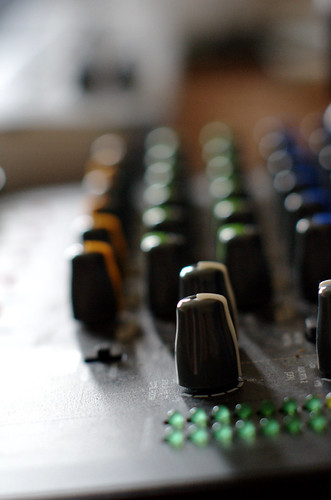
I also feel like my subject matter is rubbish. I like nature, but then, so does practically every female amateur photographer on Flickr. My nature shots are nice but they are nothing particularly special or outstanding. I need something else to shoot; my portfolio is in danger of becoming dangerously samey.
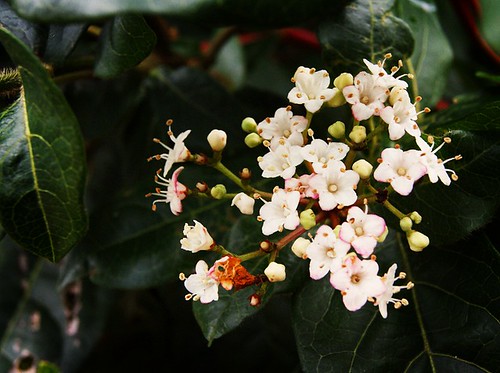
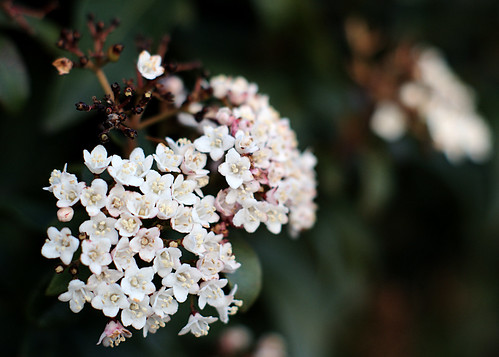
Two shots; the first taken on February 27th, the second on April 16th. I don't need to say much more do I?
I started the 365 Project to help me learn and improve through practice, but now I feel like it's hampering me a bit. Maybe I should stop it? I dunno. I have a new lens coming this week, a 70-300mm zoom lens, so maybe the new perspective will help me get a little more inspired.

I also feel like my subject matter is rubbish. I like nature, but then, so does practically every female amateur photographer on Flickr. My nature shots are nice but they are nothing particularly special or outstanding. I need something else to shoot; my portfolio is in danger of becoming dangerously samey.


Two shots; the first taken on February 27th, the second on April 16th. I don't need to say much more do I?
I started the 365 Project to help me learn and improve through practice, but now I feel like it's hampering me a bit. Maybe I should stop it? I dunno. I have a new lens coming this week, a 70-300mm zoom lens, so maybe the new perspective will help me get a little more inspired.
Subscribe to:
Posts (Atom)
